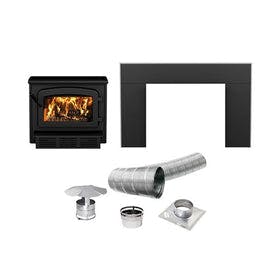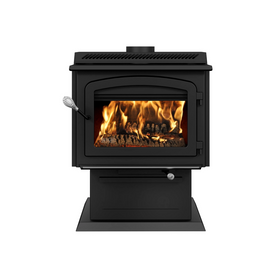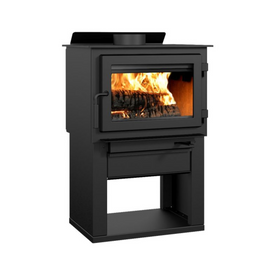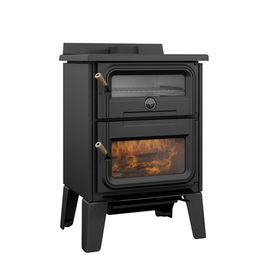
Rocket Mass Heater Guide: An Energy-Efficient Heating Option
Last Updated: Feb 8, 2025In the winter of 2017, the Energy Information Administration (EIA) estimated that it would cost an average of $644 to heat a home with natural gas, $980 with electricity, $1,462 with heating oil, and $1,661 with propane. For many households, this is one of the significant utility expenses. For many, it is also a substantial contributor to greenhouse gas emissions. If you heat with natural gas, you can expect to emit an average of around 6,400 pounds of carbon dioxide each year. In comparison, electric heating systems contribute an average of 4,700 pounds.
New technologies such as a programmable thermostat or this solar heat pump have the opportunity to drastically reduce or even eliminate greenhouse gas emissions associated with heating your home during the winter. Homes are continuing to increase in size, which subsequently increases the heating demand. One study finds that homes built between 1990 and 2001 used an average of 43,000 Btu per square foot of heated area per year. As homes get bigger, more energy will be needed to stay warm during the winter.
The Growth of Wood as a Heating Option
Your grandparents might have heated their home with a wood stove. The image of splitting wood during a snowstorm to warm the house is most often considered nostalgia.
However, the 2010 Census found that wood was the fastest growing heating fuel in the United States. In 2010, around 2.4 million households used wood as a primary heat source, while up to 12 percent of all households used wood for secondary heating purposes.
The main benefit of using wood to heat your home is trees are a renewable resource. The oil or natural gas your burn to heat your home will never again be available. Trees like the Douglas Fir or Cedar are fast-growing and grow to a harvestable size within 40-50 years.
As a fuel source, trees will actively capture and sequester carbon dioxide from the atmosphere while they grow. Burning wood creates greenhouse gas emissions to the tune of 200 g of CO2 per kilogram of wood burnt. However, trees can absorb up to 1 ton of carbon dioxide by reaching 40 years of age. This absorption makes them carbon neutral or even a carbon positive fuel source for heating your home.
Table of Contents
- What is a Rocket Mass Heater?
- How Does a Rocket Mass Heater Work?
- Is a Rocket Mass Heater Environmentally Friendly?
- How Do You Clean a Rocket Mass Heater?
- Are Rocket Mass Heaters Legal?
- Are Rocket Mass Heaters Safe?
- How Do You Install a Rocket Mass Heater in a Home?
- What Can You Burn in a Rocket Mass Heater?
- Can Rocket Mass Heaters Be Used in a Mobile Home?
- Does a Rocket Mass Heater Need to Be Vented?
- Do You Need a Smoke or Carbon Monoxide Detector if You Have a Rocket Mass Heater?
- How to Build a Rocket Mass Heater for Under $100
- Who Builds Rocket Mass Heaters?

What is a Rocket Mass Heater?
Rocket mass heaters are a space heating system expanded from the rocket stove, which is considered one of the most efficient wood-burning technologies. The rocket mass heater offers much higher efficiency ratings and claims to be able to heat your home with 80 to 90 percent less wood fuel. This is due to the rocket mass heater design as it allows hotter and more efficient combustion of wood fuel while also allowing for the heat produced to be slowly released.
How Does a Rocket Mass Heater Work?
Rocket mass heaters include an insulated combustion chamber where wood can be burned at extremely high temperatures to maintain maximum heating efficiency. Whereas most of the heat in a traditional fireplace or wood stove escapes out of the chimney, the rocket mass heaters' thermal mass absorbs the heat. It then slowly releases the heat over time into the surrounding area.
Is a Rocket Mass Heater Environmentally Friendly?
Rocket mass heaters can reduce the amount of greenhouse gas emitted into the atmosphere. One of the main environmental problems associated with heating your home with wood is methane and nitrous oxide emissions. The National Association of Home Builders found 99 percent of residential methane emissions come from "inefficient combustion of wood in fireplaces and woodstoves." Of course, methane is one of the most potent greenhouse gasses. By focusing on efficient combustion technology, the rocket mass heater helps minimize the release of these gasses.
How Do You Clean a Rocket Mass Heater?
Like a traditional wood stove, a rocket mass heater requires cleaning as ash builds up over time and use. Ash build-up occurs in the feed tube (also known as the fuel magazine), where the wood is inserted for burning. The cleaning schedule is dependent on usage, but it's recommended to clean the feed tube bi-weekly to ensure maximum efficiency. Depending on the amount of access you have, the feed tube can be cleaned with a small shovel, a container, or the hose of a vacuum. If you plan to use a vacuum, it's important to use one with a filter to prevent the ash from spreading throughout the area. Cleaning should only occur when the rocket mass heater is completely cooled.
Are Rocket Mass Heaters Legal?
While rocket mass heaters are technically legal in most places, always review local, state, and federal laws before installing a rocket mass heater. Contact your local building officials to obtain a permit and information on any installation restrictions and inspection requirements in your area. Before installing a rocket mass heater in your home, contact your insurance company to understand what conditions or requirements they may have.
Are Rocket Mass Heaters Safe?
Yes, when they have been tested and certified. Manufacturers offer certified rocket mass heaters that meet listing and labeling standards. While labeling may differ between the United States and Canada, look for rocket mass heaters that possess product safety and performance marks from UL, ULC, or Warnock Hersey. These rocket mass heaters have been laboratory tested and meet government safety guidelines in their applicable regions.
How Do You Install a Rocket Mass Heater in a Home?
Rocket mass heaters should only be installed and operated following the manufacturer's instructions. Contact local building and fire officials about restrictions, installation, and inspections required in your area. Rocket mass heaters should not be connected to a chimney flue serving another appliance. Local building codes may specify alternative requirements, including installation and location considerations.
Manufacturer documentation specifies a non-combustible, NRTL listed floor protector with an R-value of at least 2, 6" inch diameter black stove pipe (24 gauge minimum) and an NRTL listed 6" inch diameter class HT-103 steel or masonry chimney system.

What Can You Burn in a Rocket Mass Heater?
Only natural wood, cordwood, twigs, and branches should be burned in rocket mass heaters. Never use artificial logs, flammable liquids, petroleum products, coal, propane, plastic, foam, or other gas-based fuels.
Can Rocket Mass Heaters Be Used in a Mobile Home?
Rocket mass heaters are not listed or approved for use in mobile homes in North America.
Does a Rocket Mass Heater Need to Be Vented?
If installed indoors, this rocket mass heater must be connected to an approved chimney and vented outside.
Do You Need a Smoke or Carbon Monoxide Detector if You Have a Rocket Mass Heater?
For your safety, we strongly recommend installing smoke and carbon monoxide detectors throughout the house or structure the rocket mass heater is installed in.
How to Build a Rocket Mass Heater for Under $100
While we don't recommend you do this, below is a simple example of how easy it can be to improvise a rocket mass heater for a low cost. Instead, we recommend opting for rocket mass heaters that have undergone safety certifications and are sold by some manufacturers in the following section.
Rocket mass heaters can offer you a sustainable way to limit the CO2 emissions associated with heating your home. What's more impressive is with a bit of innovation and creativity, you can build one yourself for under $100 while simultaneously incorporating a heated bench into an area of your home.
- Firstly, you will need to build a J-shaped combustion chamber from fire bricks available at any fireplace supply store. The wood you burn is fed vertically into the opening of this chamber. On top of this J-shaped combustion chamber, there is a 55-gallon metal drum or barrel. This drum or barrel will capture the heat that passes through the vertical rise of the combustion chamber and radiate the heat out into your home. You can choose to leave the metal barrel exposed for maximum radiant heat. You can also surround it with brick, stone, or some other dense material. It will act as a thermal mass to capture, store, and eventually release the heat into your home.
- Horizontal metal ducting acts as the "chimney" that carries the exhaust out of your home. Unlike regular chimneys, this metal ducting is horizontal (instead of vertical). Its outer layer is some form of thermal mass such as brick or cob (an earthen material) usually made into a bench. This "thermal bench" thus further captures the heat from the exhaust and radiates it back into your home. By the time the exhaust vent eventually leaves your house, it is usually nothing more than water vapor and CO2 with minimum smoke.

Who Builds Rocket Mass Heaters?
If the thought of building a rocket mass heater is intimidating, there are companies on the market tested to specific safety certifications and might fit with local building codes.
Liberator Rocket Heaters
Liberator Rocket Heaters are tested to the Underwriters Laboratories-1482 safety standard. They can consume a range of fuel types, including pellets, sticks, twigs, split cordwood, and other pieces of wood that are less than two inches in diameter. A simple rocket heater without accessories costs $1,250. However, you should be able to notice savings within a couple of years due to a drastically lower (or even non-existent) heating bill.
Rocket Heater Gamera
Rocket Heater Gamera offers high-quality rocket mass heaters that can incorporate a horizontal exhaust system of up to five meters. Their most simple stove costs 925 euros, plus shipping costs.
As winter begins to approach, adding a rocket mass heater as your primary (or secondary) heating source is a great way to cut back on your heating bill. It also reduces the greenhouse gas emissions associated with heating your home.
Tobias Roberts
Tobias runs an agroecology farm and a natural building collective in the mountains of El Salvador. He specializes in earthen construction methods and uses permaculture design methods to integrate structures into the sustainability of the landscape.












